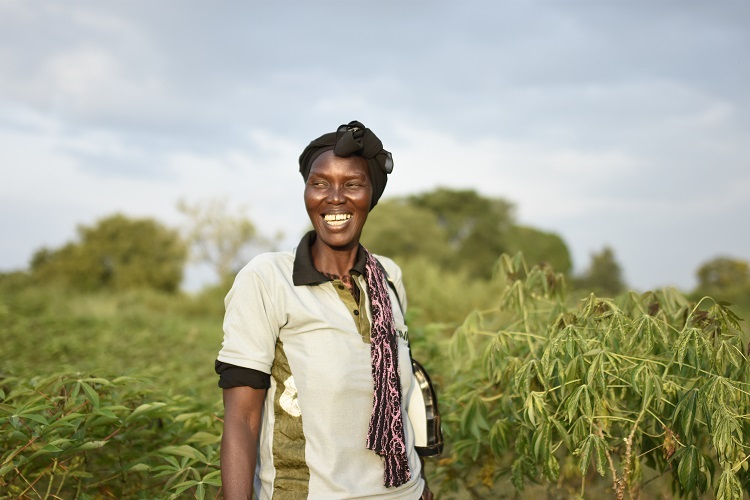
The Challenge
The tropical root crop, cassava, is a staple food that is critical to the lives and livelihoods of an estimated 450 million poor people in Africa. The crop is limited by many factors including perishability (typically 48hrs), toxicity associated with its cyanogen context, inadequate processing and lack of market opportunities.
Farmers have low yields, which could be improved by adoption of higher yielding varieties and improved agronomic practices. There is a lack of knowledge regarding best practice in scaling value chain development for the cassava sector. A value chain in this context identifies the set of factors and activities that bring a basic agricultural product in the field to final consumption – from field to fork – where at each stage value is added.
Our Approach
NRI’s Professor Andrew Westby and colleagues have developed a world-leading portfolio of strategic and adaptative interdisciplinary research to support cassava value chain development in Africa. Prior to 2000, research focused on understanding mechanisms of cyanogen reduction during cassava processing. Subsequently, research focused on the efficient and safe transformation of perishable roots into shelf-stable products, such as high-quality cassava flour (HQCF) and improved forms of traditional processed products. This included improved sun or artificial drying that is fuel efficient to overcome problems associated with mould growth and contamination of traditional products by mycotoxins (produced by fungi and can negatively affect human health). The team has produced over 50 scientific publications investigating cassava value chain development.

The team developed appropriate quality management protocols to support the production of high-quality and food-safe products to meet market demands, with complementary work on understanding desirable consumer attributes through sensory evaluation studies. The UK’s Department for International Development and the European Commission funded further projects on value chain development. The first phase of the Cassava Adding Value for Africa (CAVA) project (2008–2013), supported by the Bill & Melinda Gates Foundation (BMGF), focused on understanding the processes of scaling up and scaling out smallholder-inclusive and sustainable cassava value chains. The team established smallholder-inclusive value chains for HQCF; by 2014, the initiative had worked with an estimated 90,000 farmers, mobilising 170,000 tonnes of cassava roots, with a gross value added to rural communities of an estimated USD33 million. This facilitated the impact of the second phase of the project (CAVA2, 2014–2019), where the project team, led by Prof Westby, and Professor Adebayo of the Federal University of Agriculture, Abeokuta (FUNAAB), Nigeria, worked with partners in Nigeria, Ghana, Uganda, Tanzania and Malawi to scale up and scale out value chain development with additional BMGF funding (USD18,816,547). CAVA2 focused on value chains for HQCF, chips, starch, ethanol, improved traditional products and animal feed.
In 2012, with over GBP4 million in funding from the European Union, NRI developed technologies and systems to support cassava value chain development including new market opportunities to drive processed product adoption, e.g. using spent cassava flour from brewing beer for snack foods and utilisation of wastes from cassava processing.

Our Impact
NRI’s research on value chain development describes the impact pathway and scale up from strategic research on cassava fresh root transformation to make safe, cheap and valued products for food and industrial use. Adaptive interdisciplinary research on value chain scaling led to market-based solutions for cassava to be used as a diverse commercial/industrial commodity. The amount of cassava roots mobilised and the gross income from its sale and processing was over tenfold that of 2014. In total, 2,371,865 tonnes of roots were purchased between 2014–2019 from farmers across all five countries, over 70% of which went to new value chains; smallholder gross income from the sale of cassava roots was USD134,600,000 and processor gross income was USD234,500,000, giving a combined total of USD369,100,000.
- The team tailored business models to each country, location and market context and developed implementation plans to enable both women and men to participate and benefit. At project end, the number of direct beneficiaries totalled 153,738. Allowing for an average family size of five, an estimated 750,000 people benefitted. There is evidence that beneficiaries increased their wealth and assets (e.g. radio, television, fan, generator and sewing machine), particularly women. Women’s asset status improved more than men’s in some dimensions, contributing to narrowing the gender gap in some categories, and empowering women.
- Farmers that adopted productivity-enhancing technologies (i.e. for increasing yields – such as using improved planting material, applying fertiliser and herbicide, etc.) and supply management practices (lessons learned from CAVA Phase I) saw an increase in income which enhanced their quality of life as well as their households. Smallholders increased their yields by 58–154% (dependent on country) in response to market demands.
- NRI research contributed to reduced fuel usage and enhanced quality assurance, e.g. improvements in Nigerian drying technologies: fuel usage reduced from 374–65 litres/tonne of dried product; throughput increased from approximately 100kg/hour to around 330kg/hour of dried product and efficiency increased from 11–55%. CAVA built the capacity of a local equipment manufacturer, and made improvements in collaboration. Overall, 87 flash dryers were installed, in Nigeria, Tanzania, Malawi, and Uganda. In Ghana, one locally fabricated flash dryer and 21 bin dryers were installed.
- The team’s research contributed to understanding the risks of poorly dried cassava and the importance of safe processing, e.g. to avoid mycotoxin contamination. Sun-drying operations were used by 1,270 community processing groups in all five countries and accounted for 32.5% of the cassava roots mobilised by CAVA2. Many of the 569 small and medium-sized enterprises engaged in CAVA2 also used sun-drying because of lower capital investment costs; it also allowed farmers to engage in processing, and to benefit from value addition.
For its contributions to the CAVA project, NRI was awarded the Times Higher Education Award for International Collaboration of the Year (2014), the Guardian University Award for Research Impact (2015), and the Queen’s Anniversary Prize for Further and Higher Education (2015) – awarded every two years by Her Majesty the Queen to recognise and encourage outstanding work carried out by UK colleges and universities, the Queen’s Anniversary Prize is the highest national Honour awarded in UK further and higher education.
Our Partners
- Federal University of Agriculture, Abeokuta (FUNAAB)
- Food Research Institute, Ghana
- African Innovations Institute, Uganda
- Tanzania Food and Nutrition Centre
- University of Malawi
Key publications
- Wareing, P. W., Westby, A., Gibbs, J. A., Allotey, L. T. and Halm, M. (2001). Consumer preferences and fungal and mycotoxin contamination of dried cassava products from Ghana. International Journal of Food Science & Technology, 36(1), 1-10. (doi.org/10.1111/j.1365-2621.2001.00419.x)
- Sanni, L.O., Adebowale, A.A., Filani, T.A., Oyewole, O.B. and Westby, A. (2006) Quality of flash and rotary dried fufu flour. Journal of Food, Agriculture & Environment Vol.4 (3&4): 74-78. (doi.org/10.1234/4.2006.920)
- Tomlins, K., Sanni, L., Oyewole, O. B., Dipeolu, A., Ayinde, I., Adebayo, K. and Westby, A. (2007) Consumer acceptability and sensory evaluation of a fermented cassava product (Nigerian fufu). Journal of the Science of Food and Agriculture, 87, 1949-1956. (doi:10.1002/jsfa.2941)
- Obadina, A.O., Oyewole, O.B., Sanni, L.O., Tomlins, K.I. and Westby, A. (2007) Identification of hazards and critical control points (CCP) for cassava fufu processing in South-West Nigeria. Food Control, 19,22-26. (doi:10.1016/j.foodcont.2007.01.002)
- Lamboll, R., Nelson, V., Posthumus, H., Martin, A., Adebayo, K., Alacho, F., Dziedzoave, N., Mahende, G., Sandifolo, V., Sanni, L., Abayomi, L., Graffham, A., Hillocks, R. and Westby, A. (2015) Practical lessons on scaling up smallholder-inclusive and sustainable cassava value chains in Africa. Food Chain, 5 (1-2). pp. 28-52 (doi.org/10.3362/2046-1887.2015.004)
Contact: Prof Andrew Westby | +44 (0)1634 88 3478 |
